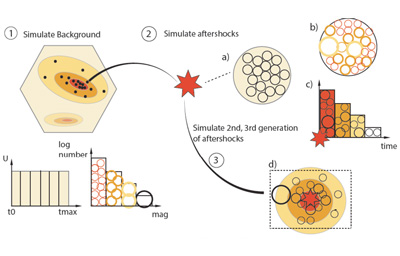Statistical Seismology
Rather than examining individual earthquakes, we (the statistical seismology group) study earthquake sequences and, more generally, seismicity—the distribution of earthquakes in space, time, and magnitude. We are interested in how earthquakes cluster and how they interact with each other. We want to know the expected size of the largest earthquake in a region in a given period, and we want to understand how seismicity will affect residents.

What we do
Ultimately, we are interested in earthquake predictability: what aspects of seismicity can be forecast, and to what extent? To address these questions, we develop models of seismicity and use them to generate forecasts for experiments in Switzerland, Italy, California, Japan, China, and elsewhere. Using these experiments, we think carefully about how to assess seismicity forecasts to make inferences about models, seismicity, and the driving geophysical processes. Ideally, this process is cyclical: we use results from experiments to improve our models.
We use statistics to explore earthquake data, test hypotheses, estimate earthquake rates, and formulate stochastic models. The figure above illustrates one such clustering model that we use to simulate earthquake catalogs. Simulated catalogs are useful for learning about our models and checking the power of our methods in an environment where we know everything about how earthquakes are generated.